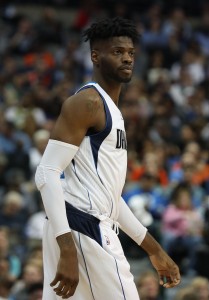The mid-level exception is the most common way for over-the-cap NBA teams to sign free agents from other clubs for more than the minimum salary. It ensures that each club heads into the offseason with a little spending flexibility, even if that team is deep into luxury tax territory.
Each team is eligible to use a specific type of mid-level exception depending on its proximity to the salary cap. The most lucrative kind of mid-level is available to teams that are over the cap but less than $6MM above the tax threshold. Still, clubs deep into the tax, and even those under the cap, have access to lesser versions of the MLE. Here’s a glance at how all three forms of the exception are structured:
For over-the-cap teams:
- Commonly called either the full mid-level exception, the non-taxpayer’s mid-level exception or simply the mid-level exception.
- Contract can cover up to four seasons.
- First-year salary is worth $8,406,000 in 2017/18.
- Once used, the team cannot surpass the “tax apron” ($6MM above tax line) for the remainder of the season.
For teams above the cap and the tax apron:
- Commonly called the taxpayer’s mid-level exception.
- Contract can cover up to three seasons.
- First-year salary is worth $5,192,000 in 2017/18.
For teams with cap room:
- Commonly called the room exception.
- Contract can cover no more than two seasons.
- First-year salary is worth $4,328,000 in 2017/18.
Each form of the mid-level allows for annual raises of up to 5% of the value of the first season’s salary. Back in June, we broke down the maximum total salaries that players signed using the mid-level exception could earn. Those numbers can be found right here.
While teams can use their entire mid-level exception to sign one player, as the Spurs did this year with Rudy Gay, clubs are also allowed to split the mid-level among multiple players, and that’s a common course of action. For instance, the Grizzlies have used their MLE to complete four separate signings, devoting parts of it to Ben McLemore, Ivan Rabb, Rade Zagorac, and Dillon Brooks.
Players drafted near the top of the second round often sign contracts for part of the mid-level because it allows teams to give them contracts for more years and more money than the minimum salary exception provides. For example, the Grizzlies used their mid-level to sign Ivan Rabb to a three-year contract that starts at $950,000. Without the MLE, Memphis would have been limited to a two-year deal starting at $815,615, and would have only had Early Bird rights on Rabb when his contract ended, rather than full Bird rights.
Some front offices prefer to leave all or part of their mid-level exception unused in the offseason so it’s still available near the end of the regular season — at that point, a contender could use its MLE to try to sign an impact veteran on the buyout market, while a rebuilding club could use it to lock up an intriguing developmental player to a long-term contract.
Unlike the bi-annual exception, the mid-level exception can be used every season. So whether or not a team uses its mid-level in 2017/18, each club will have the opportunity to use some form of the MLE when the new league year begins on July 1, 2018.
Under the old Collective Bargaining Agreement, the mid-level exception increased annually at a modest, fixed rate, which limited its value as the salary cap spiked. However, under the new CBA, the mid-level will increase at the same rate as the salary cap, ensuring that its value relative to cap room remains about the same from year to year. Based on the NBA’s current $101MM salary cap projection, the 2018/19 non-taxpayer MLE would start at $8,567,770.
Note: This is a Hoops Rumors Glossary entry. Our glossary posts will explain specific rules relating to trades, free agency, or other aspects of the NBA’s Collective Bargaining Agreement. Larry Coon’s Salary Cap FAQ and the Basketball Insiders salary pages were used in the creation of this post.
Earlier versions of this post were published in 2012, 2013, 2014, 2015, and 2016 by Luke Adams and Chuck Myron.

